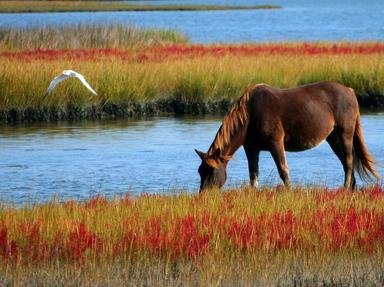Quiz Answer Key and Fun Facts
1. We begin with a rare breed of draft horse which dates back only to the early 20th century. This breed comes in only two colors, either gold-champagne or chestnut. The breed was threatened by the advent of farming mechanisation in the middle of the century but population numbers have been growing steadily since the 1980s. Which breed is this?
2. Although this breed dates back to the 14th century, there are now less than 600 known individuals and the breed is endangered. Typically chestnut, bay, roan or occasionally black, they are native to the forested region of Kirov Oblast in western-central Russia. Which breed is this?
3. The breed pictured here is named after the river than runs through the region of central Portugal where it is indigenous. Lean and leggy, this breed is particularly noted for its convex profile and its distinctive dun colouring. Which breed is this?
4. Known for their ambling gait and distinct inward-turning ear tips, this hardy breed that can be found in just about every equine colour is native to the northwestern Indian state of Rajasthan. They were originally bred as cavalry horses in the 12th century. Which breed is this?
5. Usually less than eight hands (32 inches) tall at the withers, these are not ponies but the world's smallest horse breed. Developed in Argentina, its bloodlines come from Spain, Portugal and other European stock. Intelligent and easily trained, they are ideal for teaching small children to ride and they are also used for pulling small carts. Which breed is this?
6. This breed was developed in the 16th century in Austrian Empire, although their ancestors can be traced back more than 900 years before that. More recently, the breed has been closely associated with the famous Spanish Riding School. This breed is ideally suited to the disciplines of dressage. Which breed is this?
7. Developed in the late 19th century in Austria and northern Italy, this small breed of chestnut horses is known for its unusual gait. Known for their hardiness, they are at home in challenging, mountainous terrain and the Austrian Army still uses them as pack animals today. Which breed is this?
8. One of the first developed in the U.S., the pictured breed has been used for pulling coaches, for harness racing, and as cavalry horses on both sides during the American Civil War. Usually bay, black or chestnut, this is the state horse of Massachusetts and the state animal of Vermont. Which breed is this?
9. These heavy chestnut-coloured draft horses bred in England date back to the 16th century. Originally used exclusively for farm work, as mechanization took over farms so they were used for pulling coaches and artillery. Today their main jobs are in forestry work. Which breed is this?
10. This breed began life in the 1730s in Germany at the instruction of King George II of England. One of the oldest European 'warmblood' breeds, they were originally used as carriage horses. Today, they are much in demand by Olympic equestrians, having won gold medals at all three Olympic disciplines. Which breed is this?
Source: Author
EnglishJedi
This quiz was reviewed by FunTrivia editor
guitargoddess before going online.
Any errors found in FunTrivia content are routinely corrected through our feedback system.

